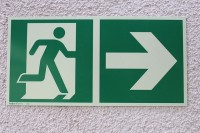What parents need to know about mass shootings
In the days after the Las Vegas shooting – the deadliest mass shooting in American history – I read an article that details expert advice on what regular people should do if we find ourselves in a situation with an active shooter. After reading it, I hovered my finger over the “share” button as I debated about whether or not to send it to my two oldest kids, ages 15 and 13. These were not the lessons I ever planned on sharing with them.
But I also want to do all I can to equip them for an imperfect and sometimes violent world, so I hit the send button. Because of the article’s length and level of detail, I didn’t share it with my 10-year-old, choosing instead to talk to her about the main points in a conversation I hope didn’t make her feel afraid. I told her about it because history has shown us that gunmen won’t bypass the youngest and most tender of targets.
In case you’d like to share the same information with the people you love, here are the five main takeaways I learned from the article titled “What to Do in an Active Shooter Situation,” by Brett and Kate McKay.
Point 1: Always know where the exits are. In any public setting, make a mental note of at least two ways you could get out of the building or the area if you needed to do it quickly. (Always consider lesser-known exits like the back door of a restaurant or grocery store, or the side exit in a movie theater.)
Point 2: Notice when something looks, sounds or feels “off.” Be relaxed but watchful, in a mode of “condition yellow,” and take note of things that don’t seem normal. “Bottom line: Don’t have your nose constantly in your smartphone and don’t zone out. …Constantly scan your environment to take in what’s going on.”
Point 3: Don’t assume it’s fireworks. In many shootings, witnesses say they thought the sound was fireworks, which may be because of something called “normalcy bias.” This bias makes people act like things are normal even when they’re not. “Our brain is predisposed to assume that things will carry on in a predictable way. When the pattern is broken, it takes a long time for the brain to process this aberration,” McKay writes. Fireworks are normal. Someone randomly shooting into a crowd is not. But don’t stand still waiting for someone to confirm it was only fireworks. There’s just no time.
Point 4: Speaking of time, remember this number: two minutes. The article states that a study done in 2014 by the FBI finds that most active shootings are over in two minutes or less, which isn’t usually enough time for police to arrive. As soon as you hear what could be a gunshot, you should immediately move.
Point 5: Run. Experts interviewed in the article agree that running for an exit and putting as much space between you and the gunman is the best thing you can do. Even if no one else around you is running, you should still run. (Remember that other people might be standing around waiting for things to go back to normal.)
Don’t grab your stuff first. Don’t call 911 first. Just run. (If you’re in an open area, run in a zig-zag pattern.) A moving target is more difficult to hit, even for experienced shooters.
If you’re not able to run, hiding behind locked doors or barricades is the second-best option, experts say. Attacking the gunman is the last option you should take, only if the other two options aren’t possible.
If you have an opportunity to read the entire article, I recommend it. (Click here to read “What to Do in an Active Shooter Situation.”) Or talk to your family about what you would do as a group. Even though it’s a difficult subject none of us want to consider, there’s no denying the reality in which we live – a reality that says sometimes, on the darkest of days in America, it’s not just fireworks.
 Gwen Rockwood is a mom to three great kids, wife to one cool guy, a newspaper columnist and co-owner of nwaMotherlode.com. To check out Gwen’s book, “Reporting Live from the Laundry Pile: The Rockwood Files Collection,” click HERE.
Gwen Rockwood is a mom to three great kids, wife to one cool guy, a newspaper columnist and co-owner of nwaMotherlode.com. To check out Gwen’s book, “Reporting Live from the Laundry Pile: The Rockwood Files Collection,” click HERE.
